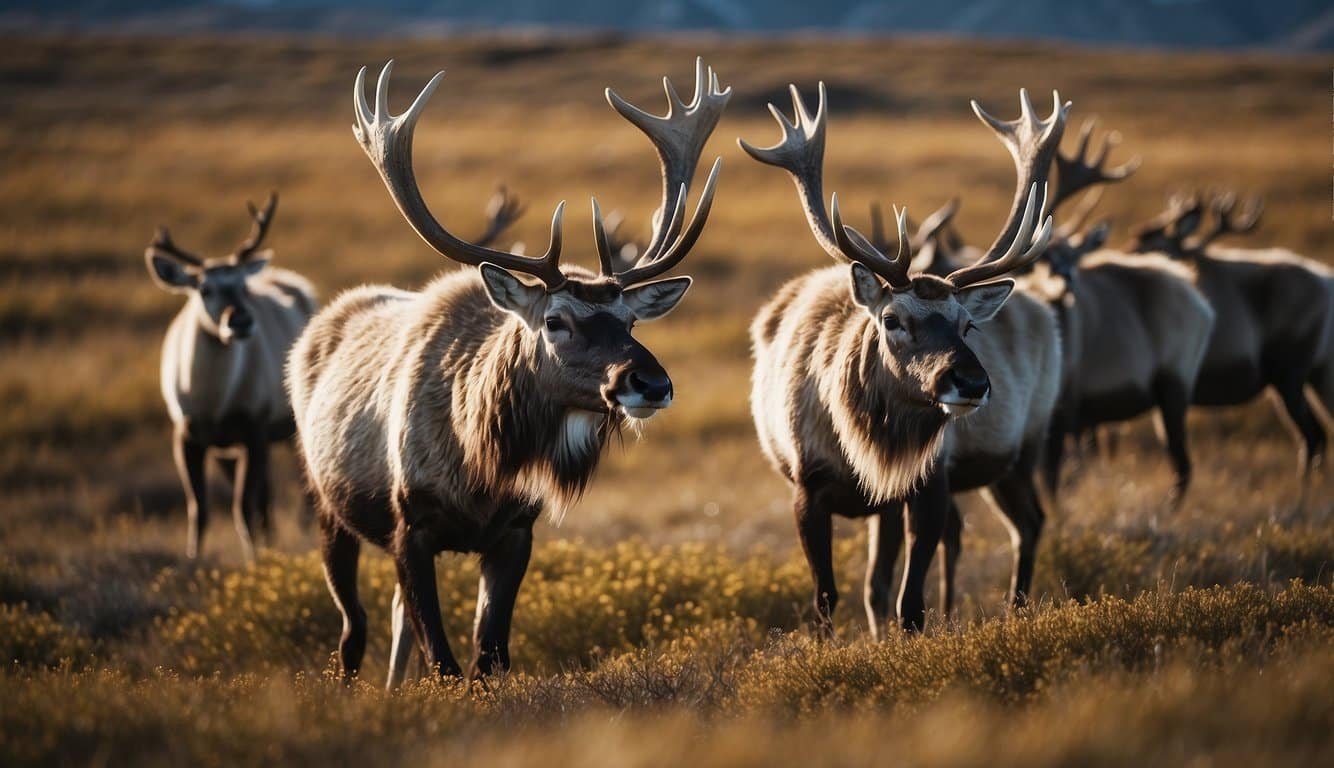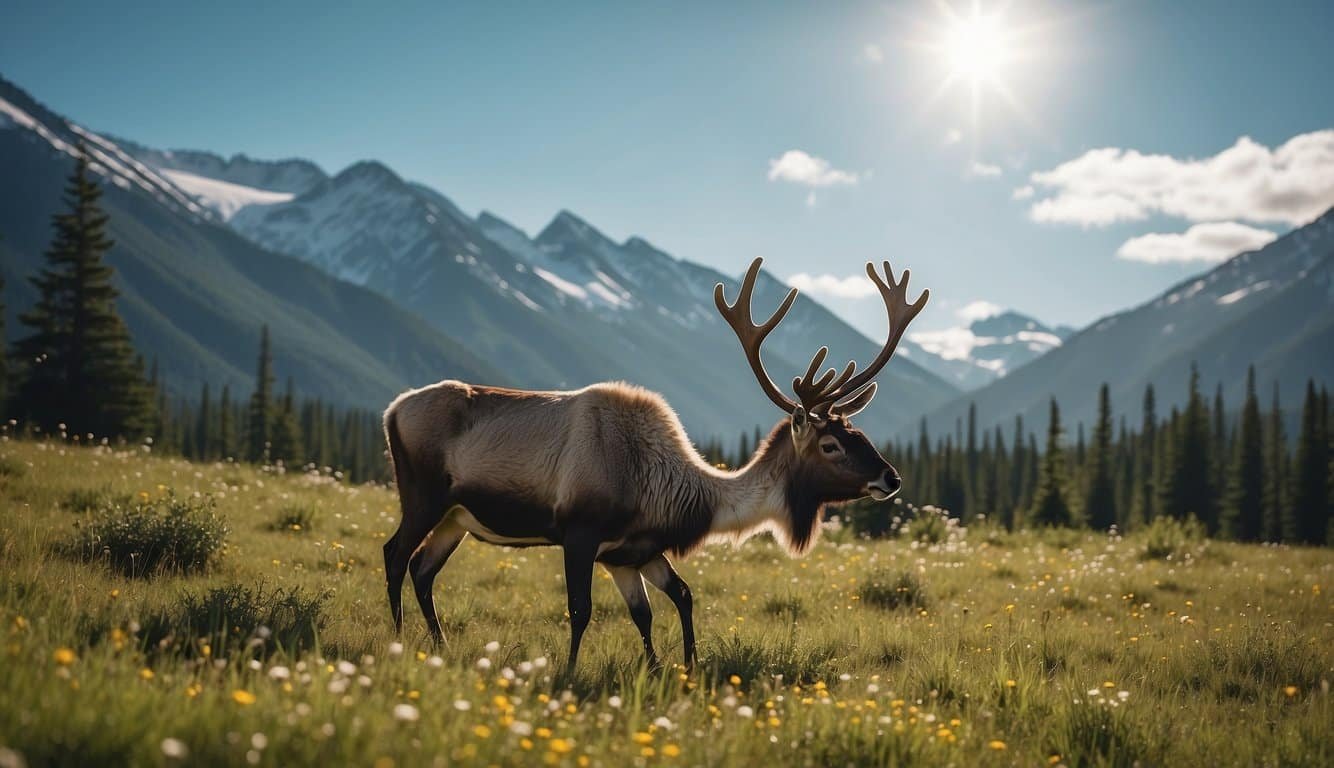Caribou Basics
Caribou, also known as reindeer in Europe, are fascinating creatures of the Arctic and sub-Arctic regions. Their unique adaptations give them a special place in ecosystems and cultures around the world.
Physical Characteristics
Caribou possess several distinctive physical features that have enabled them to thrive in cold environments. Males and females both grow antlers, though the size and shape may vary between sexes and subspecies. These antlers are covered in velvet, a soft tissue which nourishes the bone as it grows before being shed annually.
| Feature | Description |
|---|---|
| Size | Adult caribou average between 4 to 5 feet at the shoulder. |
| Weight | Males can weigh up to 700 pounds, while females typically reach up to 300 pounds. |
| Color | Their coat color can range from dark brown in summer to almost completely white in winter. |
These changes not only provide camouflage but also help regulate their body temperature throughout the seasons.
Taxonomy and Species
Rangifer tarandus is the scientific name for the species which encompasses both caribou and reindeer. They are the same species, but the name reindeer is commonly used for domesticated animals, especially in Europe, while caribou refers to the wild populations mostly found in North America. There are several subspecies of caribou, each adapted to different habitats ranging from woodland areas to tundra.
- Woodland Caribou: Typically larger with thicker fur, these caribou are found in the forests of Canada and the northern United States.
- Barren-ground Caribou: Often lighter and more nimble, these caribou are associated with the treeless Arctic tundra.
Did you know that caribou are the only deer species in which both males and females grow antlers? While discussing caribou dynamics, researchers note that although herds can be genetically similar, subtle differences may exist based on their lineage and environment. The caribou and their close relatives have captivated scientists and wildlife enthusiasts alike, leading to a wealth of knowledge on their health, behaviors, and challenges, as thoroughly outlined in the book Reindeer and Caribou: Health and Disease.
Habitat and Behavior

Woodland caribou, majestic mammals of the North, not only survive but thrive in some of the harshest environments in North America. Their lives are a delicate dance of movement and foraging, intricately linked to the seasons and their habitats, ranging from the icy tundra to the dense boreal forests.
Seasonal Movements
Caribou are renowned migratory animals, engaging in epic journeys across the Arctic tundra and North American boreal forests. These migrations are a survival strategy, moving from one feeding area to another as the seasons dictate. In winter, caribou herds travel to the forested areas where they find shelter from the harsh conditions and better access to food. The movement patterns of woodland caribou reflect their behavioral adaptations to the environmental challenges they face throughout the year.
Diet and Foraging
During their seasonal migrations, caribou have adapted to exploit a diet that is diverse yet specialized. Their summer diet is rich in plants like grasses and sedges, while in the winter, they rely on a variety of lichens, commonly known as reindeer moss, which they dig out from under the snow using their specially adapted hooves. The availability of these food sources influences their habitat selection and foraging strategies, often dictating their migratory patterns. As herbivores, they play a pivotal role in their ecosystem by impacting the vegetation dynamics.
By understanding the caribou’s habitat and behavior, we’re granted a glimpse into the lives of these resilient creatures as they navigate the complexities of survival and adaptation in some of the world’s most extreme environments.
Conservation and Coexistence

Caribou conservation efforts are pivotal in managing and sustaining populations that face several pressures. These efforts encompass not only direct protection measures but also the careful management of human activities that intersect with caribou habitats.
Threats to Survival
Caribou, a member of the deer family, are ecologically significant and culturally important animals found across Alaska, Canada, Scandinavia, Russia, and Greenland. Despite their wide distribution, many caribou populations, such as the woodland caribou in Canada, are endangered or vulnerable due to several threats. Habitat loss, often a result of human development and climate change, stands as the primary challenge. These majestic animals require large tracts of undisturbed territory to survive, something increasingly scarce in the boreal forests which they call home. Predation and disturbance, factors that may be exacerbated by human activity, further complicate conservation efforts.
Human Interactions
Human impacts on caribou habitat, such as development and logging, have proven detrimental, leading to functional habitat loss. Conservation strategies are multifaceted, considering both direct protection of species and the mitigation of indirect impacts, like the management of wolf populations that may affect caribou indirectly via predation. It’s also crucial to account for the relationship with Indigenous peoples, who have coexisted with and depended on these animals for centuries. They often provide invaluable knowledge and leadership in conservation planning, ensuring caribou continue to stride across the northern landscapes. Meanwhile, international bodies, such as the IUCN Red List, monitor caribou populations, marking those at risk of extinction, and providing data essential for effective conservation strategies.

